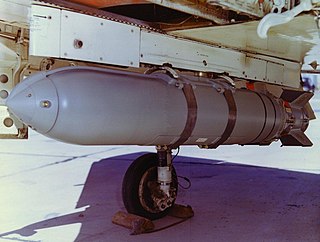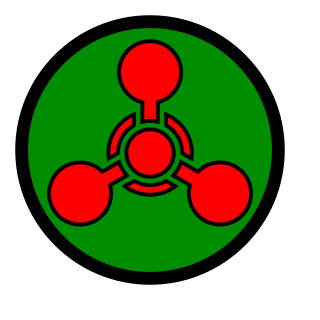
VX is an extremely toxic synthetic chemical compound in the organophosphorus class, specifically, a thiophosphonate. In the class of nerve agents, it was developed for military use in chemical warfare after translation of earlier discoveries of organophosphate toxicity in pesticide research. In recent years, VX was found to be the agent used in the assassination of Kim Jong-nam. In its pure form, VX is an oily, relatively non-volatile liquid that is amber-like in colour. Because of its low volatility, VX persists in environments where it is dispersed.

The M687 was an American 155 mm binary sarin chemical artillery shell. The design was standardized in 1976 and production began on December 16, 1987 at Pine Bluff Arsenal, Pine Bluff, Arkansas. Production was halted three years later, following the 1990 Chemical Weapons Accord between the United States and the USSR, and the dismantling of existing stocks began in November 1997 at Hawthorne Army Depot, Nevada. America's remaining stocks were stored at the Deseret Chemical Depot, Utah, and the Umatilla Chemical Depot.

The United States Army Chemical Materials Activity (CMA) is a separate reporting activity of the United States Army Materiel Command (AMC). Its role is to enhance national security by securely storing the remaining U.S. chemical warfare materiel stockpiles, while protecting the work force, the public and the environment to the maximum extent.
The Deseret Chemical Depot was a U.S. Army chemical weapon storage area located in Utah, 60 miles (100 km) southwest of Salt Lake City. It is related to the Tooele Chemical Agent Disposal Facility.
Pine Bluff Chemical Activity is a subordinate organization of the United States Army Chemical Materials Agency located at Pine Bluff Arsenal in Pine Bluff, Arkansas. The U.S. Army stored approximately twelve percent of its original chemical weapons at the Pine Bluff Arsenal since 1942. Destruction of the last chemical weapons occurred on November 12, 2010.
Blue Grass Army Depot (BGAD) is a U.S. Army Joint Munitions Command storage facility for conventional munitions and chemical weapons. The facility is located in east central Kentucky, southeast of the cities of Lexington and Richmond, Kentucky. The 14,494-acre (58.66 km2) site, composed mainly of open fields and wooded areas, is used for munitions storage, repair of general supplies, and the disposal of munitions. The installation is used for the storage of conventional explosive munitions as well as assembled chemical weapons. The depot primarily is involved in industrial and related activities associated with the storage and maintenance of conventional and chemical munitions.
Anniston Chemical Activity was a U.S. Army chemical weapon storage site located in Alabama. The Army had stored approximately seven percent of the nation’s original chemical weapons stockpile at the Anniston Army Depot since the early 1960s. In August 2003, the Army began disposing of these weapons at the Anniston Chemical Agent Disposal Facility. Destruction of the base's stockpile of VX was begun on July 23, 2006. By December 2008, all of the VX on site had been destroyed. Destruction of mustard-filled munitions began on July 2, 2009 after several months of retooling. By July 2010, it had destroyed by incineration 75% of the depot's total stockpile including all 437 tons of GB (sarin) and all VX nerve agent on site. On September 22, 2011, the last mustard gas shells were burned, completing chemical weapons disposal at the facility. The facilities were scheduled for dismantlement by about 2013 and some of the weapon-handling equipment was planned for transfer to the depots at Kentucky and Colorado. Local government emergency departments are expecting to lose millions in annual funding from the federal government related to the presence of the chemical depot and as many as 1000 jobs will be cut on the base. According to the US Army Corps of Engineers the disposal and closure of Anniston Chemical Activity were completed on May 7, 2013. Following the closure, other uses for the incinerators were explored, but ultimately they were demolished.

The Pine Bluff Arsenal is a United States Army installation in Jefferson County, Arkansas, about eight miles northwest of Pine Bluff and thirty miles southeast of Little Rock.
Operation Red Hat was a United States Department of Defense movement of chemical warfare munitions from Okinawa, Japan to Johnston Atoll in the North Pacific Ocean, which occurred in 1971.

The Blue Grass Chemical Agent-Destruction Pilot Plant (BGCAPP) is a facility built to destroy the chemical weapons stockpile at the Blue Grass Army Depot (BGAD), near Richmond, Kentucky.

Johnston Atoll Chemical Agent Disposal System (JACADS) was the U.S. Army's first chemical munitions disposal facility. It was located on Johnston Island, at Johnston Atoll and completed its mission and ceased operation in 2000.

The M55 rocket was a chemical weapon developed by the United States in the 1950s. The United States Army produced both Sarin and VX unitary warheads for the M55.
The M121/A1 155mm Projectile was a chemical artillery shell designed for use by the U.S. Army. It was designed to be used with approximately 6.5 lb (2.9 kg) of GB or VX nerve agents.

The Weteye bomb was a U.S. chemical weapon designed for the U.S. Navy and meant to deliver the nerve agent sarin. The Weteye held 160 kg (350 lb) of liquid sarin and was officially known as the Mk 116. Stockpiles of Weteyes were transferred to Utah in the 1980s amidst controversy and protest.

The last chemical weapon in the U.S. stockpile was destroyed July 7, 2023, at the Blue Grass Chemical Agent-Destruction Pilot Plant.
Throughout history, chemical weapons have been used as strategic weaponry to devastate the enemy in times of war. After the mass destruction created by WWI and WWII, chemical weapons have been considered to be inhumane by most nations, and governments and organizations have undertaken to locate and destroy existing chemical weapons. However, not all nations have been willing to cooperate with disclosing or demilitarizing their inventory of chemical weapons. Since the start of the worldwide efforts to destroy all existing chemical weapons, some nations and terrorist organizations have used and threatened the use of chemical weapons to leverage their position. Examples of the use of chemical weapons since World War II are Iraq’s Saddam Hussein on the Kurdish village Halabja in 1988 and their employment against civilian passengers of the Tokyo subway by Aum Shinrikyo in 1995. The efforts made by the United States and other chemical weapon destruction agencies intend to prevent such use, but this is a difficult and ongoing effort. Aside from the difficulties of cooperation and locating chemical weapons, the methods to destroy the weapons and to do this safely are also a challenge.

A chemical weapon (CW) is a specialized munition that uses chemicals formulated to inflict death or harm on humans. According to the Organisation for the Prohibition of Chemical Weapons (OPCW), this can be any chemical compound intended as a weapon "or its precursor that can cause death, injury, temporary incapacitation or sensory irritation through its chemical action. Munitions or other delivery devices designed to deliver chemical weapons, whether filled or unfilled, are also considered weapons themselves."
The United States chemical weapons program began in 1917 during World War I with the creation of the U.S. Army's Gas Service Section and ended 73 years later in 1990 with the country's practical adoption of the Chemical Weapons Convention. Destruction of stockpiled chemical weapons began in 1986 and was completed on July 7, 2023. The U.S. Army Medical Research Institute of Chemical Defense (USAMRICD), at Aberdeen Proving Ground, Maryland, continues to operate.












